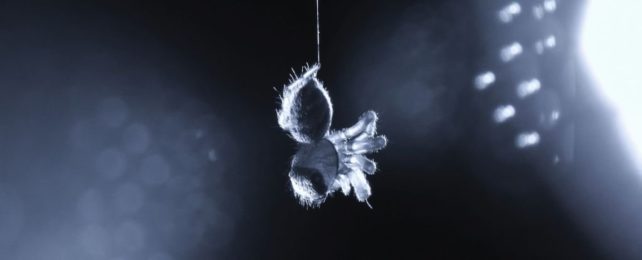A new discovery about jumping spiders could challenge some pretty hefty human assumptions about the cognitive abilities of arthropods.
According to a study that examined the motions of their eyes and bodies while they sleep, it's possible that these tiny spiders are not just resting, but dreaming – entering a sleep state fascinatingly similar to the rapid eye movement (REM) sleep observed in humans and other vertebrates.
This could expand our understanding of sleep and sleep states, and the role REM sleep plays in the cognition of animals in which it occurs.
To date, most sleep studies have been focused on vertebrate animals. It's only recently that evidence of REM sleep has been observed in invertebrates – namely, cephalopods, such as cuttlefish and octopuses.
This has raised some really interesting questions: do these creatures dream? Which other animals experience REM sleep?
Perhaps answering these questions could lead us to the answers to even more baffling conundrums, such as why did REM sleep evolve? What, if any, purpose does it serve?
Recently, a team of researchers led by behavioral and evolutionary ecologist Daniela Roessler of Harvard University found that a species of jumping spider called Evarcha arcuata appeared to sleep.
At dusk, the tiny spiders would suspend themselves from a single thread and remain in that position, motionless for the duration of the night.
Or rather, not entirely motionless. The adult spiders observed by Roessler and her colleagues exhibited periods of heightened activity: their little legs and spinnerets and abdomens would twitch, or their legs would curl up in what appeared to be a defensive posture.
The motions, the team observed, seemed similar to the REM sleep twitchings of cats and dogs. But, in adult spiders at least, it was difficult to determine exactly what the spiders were doing.
Juveniles of the species, however, are not subject to the same limitations. Their still-growing and maturing bodies are unpigmented, and therefore transparent. This means that it's possible to view, and record, what's going on inside their bodies during this period of night-time inactivity.
In particular, the spiderlings' retinal tubes. Jumping spiders' large, black, limpid eyes are fixed in their small heads, and don't move; but their retinal tubes can shift to adjust the spiders' vision as they go about their important spider business.
A diagnostic indicator of REM sleep is, well, rapid eye movement. Direct observation of the retinal tubes of E. arcuata spiderlings, therefore, could reveal if what's happening to these spiders is, in fact, similar to REM sleep.
 Retinal movement and leg twitching and curling in a spiderling. (Roessler et al., PNAS, 2022)
Retinal movement and leg twitching and curling in a spiderling. (Roessler et al., PNAS, 2022)
The researchers filmed 34 E. arcuata spiderlings in four-hour segments as they went about their night-time affairs. They also trained a neural network to enable them to identify retinal movement in the spiders. Then, they carefully studied the resulting videos.
Not only did their videos capture retinal movement in the slumbering spiders, that retinal movement neatly matched up with the twitchings and curlings of spinnerets and legs.
In fact, every observed instance of leg curling was associated with a bout of retinal movement (although leg curling wasn't seen in every retinal movement bout).
Sometimes, the spiderlings would stretch, or clean themselves. These instances would occur, the researchers noted, not long after REM-like states, but were not associated with retinal movement themselves. This, the researchers believe, indicates brief periods of waking.
 A spiderling having a stretch. (Roessler et al., PNAS, 2022)
A spiderling having a stretch. (Roessler et al., PNAS, 2022)
The retinal movement bouts were observed, as they are in other animals, occurring at intervals during which the spiders were still, and for durations that were comparable with REM sleep in other organisms. This, the researchers said, ticks all the boxes.
"This report provides direct evidence for an REM sleep-like state in a terrestrial invertebrate – an arthropod – with clear parallels to REM sleep in terrestrial vertebrates," they wrote in their paper.
"The combination of periodic limb twitches and eye movements during this sleep-like state as well as the increase of duration of REM sleep-like bouts meets core behavioral criteria of REM sleep observed in vertebrates, including humans."
What's interesting about this study is that jumping spiders are highly visual little arthropods, with spectacularly good eyesight.
The front of their faces are mounted with two huge eyes, for their size, and they have six smaller eyes arrayed around their heads for a large field of vision. Research even suggests that their sight might be tetrachromatic.
In humans, eye movement patterns during REM sleep are suspected to be directly linked to the visual 'movie-like' experience of dreaming.
So a spider's sleep might also include visual dreams, or might have a function that has something to do with vision. Other spiders, which rely less on vision and more on, say, vibration to sense the world, might experience a REM-like sleep differently.
Further research into other sleeping creatures could reveal a lot more – and give some new insights into the purpose of sleep, and of dreams.
"While sleep is ubiquitous in the animal kingdom, it remains to be demonstrated whether REM-like sleep is equally universal and how these sleep phases may be expressed in less visual species," the researchers wrote.
"Conversely, eye movement during REM sleep may be a unique feature of visual brains, with this convergent evolution suggesting some critical vision-specific functionality."
The research has been published in PNAS.
